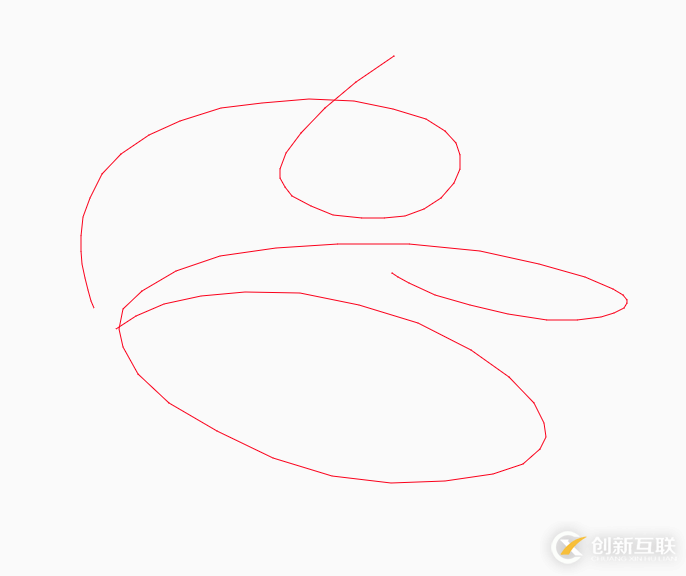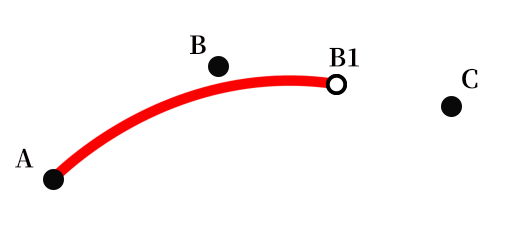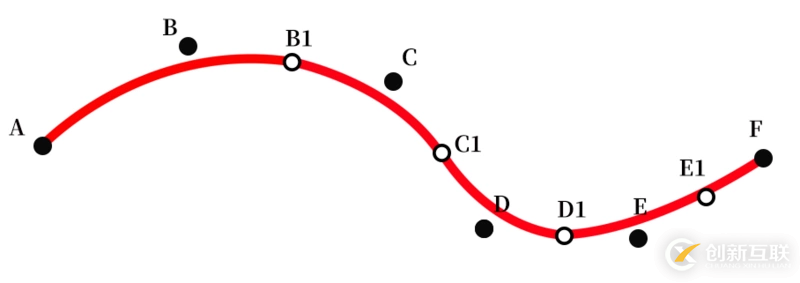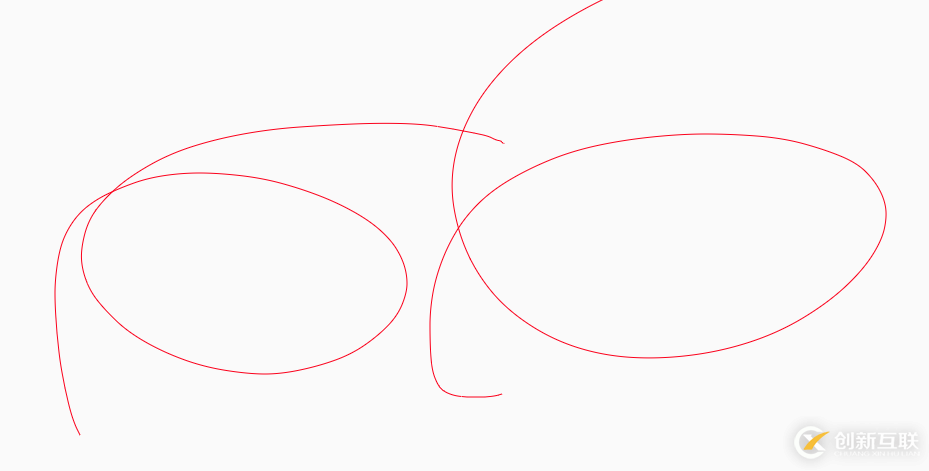canvas小畫板之平滑曲線的實(shí)現(xiàn)案例-創(chuàng)新互聯(lián)
小編給大家分享一下canvas小畫板之平滑曲線的實(shí)現(xiàn)案例,相信大部分人都還不怎么了解,因此分享這篇文章給大家參考一下,希望大家閱讀完這篇文章后大有收獲,下面讓我們一起去了解一下吧!

功能需求
項(xiàng)目需求:需要實(shí)現(xiàn)一個(gè)可以自由書寫的小畫板
簡單實(shí)現(xiàn)
對(duì)于熟悉canvas的同學(xué)來說,這個(gè)需求很簡單,大致邏輯如下:
1)監(jiān)聽事件pointerdown,pointermove,pointerup
2)標(biāo)記是否拖拽畫線模式變量 isDrawing,在down事件時(shí)置為true,up的時(shí)候置為false
3)使用canvas的api,設(shè)置線條樣式,調(diào)用繪制線條接口lineTo方法
短短幾十行代碼就能實(shí)現(xiàn):
<!doctype html>
<html>
<head>
<meta charset=utf-8>
<style>
canvas {
border: 1px solid #ccc
}
body {
margin: 0;
}
</style>
</head>
<body style="overflow: hidden;background-color: rgb(250, 250, 250);touch-action: none;">
<canvas id="c" width="1920" height="1080"></canvas>
<script>
var el = document.getElementById('c');
var ctx = el.getContext('2d');
//設(shè)置繪制線條樣式
ctx.strokeStyle = 'red';
ctx.lineWidth = 1;
ctx.lineJoin = 'round';
ctx.lineCap = 'round';
var isDrawing;//標(biāo)記是否要繪制
//存儲(chǔ)坐標(biāo)點(diǎn)
let lastX, lastY;
document.body.onpointerdown = function (e) {
console.log('pointerdown');
isDrawing = true;
lastX = e.clientX;
lastY = e.clientY;
};
document.body.onpointermove = function (e) {
console.log('pointermove');
if (isDrawing) {
draw(e.clientX, e.clientY, lastX, lastY);
}
lastX = e.clientX, lastY = e.clientY;
};
document.body.onpointerup = function (e) {
if (isDrawing) {
draw(e.clientX, e.clientY, lastX, lastY);
}
lastX = e.clientX, lastY = e.clientY;
isDrawing = false;
};
function draw(x, y, lastX, lastY) {
ctx.beginPath();
ctx.moveTo(lastX, lastY);
ctx.lineTo(x, y);
ctx.stroke();
}
</script>
</body>
</html>實(shí)現(xiàn)效果如下圖:

以上就簡單的實(shí)現(xiàn)了畫板功能,如果要求不高的用戶可以使用,但一旦遇到有點(diǎn)要求的用戶就無法交付這種產(chǎn)品,仔細(xì)看是線條折線感太強(qiáng)。
為什么會(huì)有折線感呢?
主要原因:
我們調(diào)用的api方法lineTo是兩點(diǎn)連線也就是直線
瀏覽器對(duì)鼠標(biāo)事件mousemove的采集是有采集頻率的,并不是每個(gè)鼠標(biāo)移動(dòng)經(jīng)過的每一個(gè)像素點(diǎn)都會(huì)觸發(fā)事件。
當(dāng)鼠標(biāo)移動(dòng)的越快,那么兩點(diǎn)之間的間隔就越遠(yuǎn),那么折線感就更明顯。

如何能繪制平滑的曲線?
canvas提供的api中是有現(xiàn)成接口的,貝塞爾系列的接口就能滿足我們的要求,接下來我們講一下使用二次貝塞爾曲線繪制平滑曲線。
quadraticCurveTo(cpx,cpy,x,y)
二次貝塞爾曲線接口需要四個(gè)參數(shù),cpx,cpy是曲線的控制點(diǎn),x,y是曲線終點(diǎn)。
有人問那曲線的起點(diǎn)在哪里?其實(shí)曲線的起點(diǎn)取決于上一操作狀態(tài),可以是moveTo的位置,或者是lineTo的位置,或者是貝塞爾的終點(diǎn)。
那么怎么調(diào)用quadraticCurveTo,參數(shù)怎么傳呢?
我們需要找出關(guān)鍵位置,直接用例子告訴大家吧
1)假如我們用鼠標(biāo)采集到ABCDEF六個(gè)點(diǎn)
2)取前面三個(gè)點(diǎn)ABC計(jì)算,BC的中點(diǎn)B1,以A為起點(diǎn),B為控制點(diǎn),B1為終點(diǎn),那么利用quadraticCurveTo可以繪制出這樣一條貝塞爾曲線

3)接下來計(jì)算CD的中點(diǎn)C1,以B1為起點(diǎn),C為控制點(diǎn),C1為終點(diǎn),那么利用quadraticCurveTo可以繪制出這樣一條貝塞爾曲線

4)以此類推,當(dāng)?shù)搅俗詈笠粋€(gè)點(diǎn)時(shí)以D1為起點(diǎn),E為控制點(diǎn),F(xiàn)為終點(diǎn),結(jié)束貝塞爾繪制。

根據(jù)算法進(jìn)行代碼改造
OK我們介紹了具體算法的影響,那用該算法對(duì)我們前面的代碼進(jìn)行改造:
<!doctype html>
<html>
<head>
<meta charset=utf-8>
<style>
canvas {
border: 1px solid #ccc
}
body {
margin: 0;
}
</style>
</head>
<body style="overflow: hidden;background-color: rgb(250, 250, 250);touch-action: none;">
<canvas id="c" width="1920" height="1080"></canvas>
<script>
var el = document.getElementById('c');
var ctx = el.getContext('2d');
//設(shè)置繪制線條樣式
ctx.strokeStyle = 'red';
ctx.lineWidth = 1;
ctx.lineJoin = 'round';
ctx.lineCap = 'round';
var isDrawing;//標(biāo)記是否要繪制
//存儲(chǔ)坐標(biāo)點(diǎn)
let points = [];
document.body.onpointerdown = function (e) {
console.log('pointerdown');
isDrawing = true;
points.push({ x: e.clientX, y: e.clientY });
};
document.body.onpointermove = function (e) {
console.log('pointermove');
if (isDrawing) {
draw(e.clientX, e.clientY);
}
};
document.body.onpointerup = function (e) {
if (isDrawing) {
draw(e.clientX, e.clientY);
}
points = [];
isDrawing = false;
};
function draw(mousex, mousey) {
points.push({ x: mousex, y: mousey });
ctx.beginPath();
let x = (points[points.length - 2].x + points[points.length - 1].x) / 2,
y = (points[points.length - 2].y + points[points.length - 1].y) / 2;
if (points.length == 2) {
ctx.moveTo(points[points.length - 2].x, points[points.length - 2].y);
ctx.lineTo(x, y);
} else {
let lastX = (points[points.length - 3].x + points[points.length - 2].x) / 2,
lastY = (points[points.length - 3].y + points[points.length - 2].y) / 2;
ctx.moveTo(lastX, lastY);
ctx.quadraticCurveTo(points[points.length - 2].x, points[points.length - 2].y, x, y);
}
ctx.stroke();
points.slice(0, 1);
}
</script>
</body>
</html>在原有基礎(chǔ)上我們用了一個(gè)數(shù)組points保存鼠標(biāo)經(jīng)過的點(diǎn),根據(jù)算法可知繪制貝塞爾曲線至少要用三個(gè)點(diǎn),繪制過程中維護(hù)points數(shù)組。
實(shí)現(xiàn)效果如下,可見平滑了很多!

以上是“canvas小畫板之平滑曲線的實(shí)現(xiàn)案例”這篇文章的所有內(nèi)容,感謝各位的閱讀!相信大家都有了一定的了解,希望分享的內(nèi)容對(duì)大家有所幫助,如果還想學(xué)習(xí)更多知識(shí),歡迎關(guān)注創(chuàng)新互聯(lián)行業(yè)資訊頻道!
網(wǎng)站欄目:canvas小畫板之平滑曲線的實(shí)現(xiàn)案例-創(chuàng)新互聯(lián)
標(biāo)題URL:http://chinadenli.net/article6/ecoog.html
成都網(wǎng)站建設(shè)公司_創(chuàng)新互聯(lián),為您提供Google、App設(shè)計(jì)、外貿(mào)建站、網(wǎng)站設(shè)計(jì)公司、移動(dòng)網(wǎng)站建設(shè)、網(wǎng)站制作
聲明:本網(wǎng)站發(fā)布的內(nèi)容(圖片、視頻和文字)以用戶投稿、用戶轉(zhuǎn)載內(nèi)容為主,如果涉及侵權(quán)請(qǐng)盡快告知,我們將會(huì)在第一時(shí)間刪除。文章觀點(diǎn)不代表本網(wǎng)站立場(chǎng),如需處理請(qǐng)聯(lián)系客服。電話:028-86922220;郵箱:631063699@qq.com。內(nèi)容未經(jīng)允許不得轉(zhuǎn)載,或轉(zhuǎn)載時(shí)需注明來源: 創(chuàng)新互聯(lián)
猜你還喜歡下面的內(nèi)容
- ServiceMesh的探索和實(shí)踐-創(chuàng)新互聯(lián)
- (原)eclipse4.2.1插件安裝(一)之tomcat-創(chuàng)新互聯(lián)
- 怎么在PHP中利用array_multisort對(duì)多個(gè)數(shù)組進(jìn)行排序-創(chuàng)新互聯(lián)
- 【設(shè)計(jì)模式與Android】建造者模式——建軍大業(yè)-創(chuàng)新互聯(lián)
- 實(shí)現(xiàn)支持中文、字母、數(shù)字的PHP驗(yàn)證碼-創(chuàng)新互聯(lián)
- Centos7系統(tǒng)怎么啟動(dòng)?-創(chuàng)新互聯(lián)
- node.js中怎么利用express解析post請(qǐng)求-創(chuàng)新互聯(lián)

- 關(guān)于企業(yè)網(wǎng)站建設(shè)的解決方案 2015-02-14
- 企業(yè)郵箱注冊(cè)的問題解決方案 2013-11-24
- 數(shù)碼網(wǎng)站建設(shè)解決方案 2022-04-23
- 招聘網(wǎng)站解決方案之一 2023-03-12
- 企業(yè)網(wǎng)站建設(shè)解決方案的4個(gè)步驟 2016-11-06
- 再議商城網(wǎng)站解決方案策劃 2023-02-11
- 確定服務(wù)器解決方案 2023-01-06
- 4個(gè)常見的網(wǎng)頁設(shè)計(jì)錯(cuò)誤及其正確的解決方案 2022-07-20
- seo人員如何制定網(wǎng)站解決方案? 2015-01-23
- 鄭州共享停車位APP開發(fā)解決方案 2023-03-08
- HTTP500內(nèi)部服務(wù)器錯(cuò)誤解決方案有哪些? 2022-08-21
- 裝修行業(yè)網(wǎng)站建設(shè)怎么做?有沒有解決方案? 2016-11-09